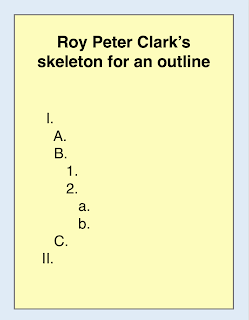Articles on planning what to write typically say to begin by constructing an outline. But there is another way to use an outline.
Wikipedia has an article on Outline which also contains the following description:
“A reverse outline is an outline made from an existing work. Reverse outlining is like reverse engineering a document. The points or topics are extracted from the work, and are arranged in their order of presentation, by section, in the outline. Once completed, the outline can be filled in and rearranged as a plan for a new improved version of the document.”
This week I am reading Ron Friedman’s 2022 book Decoding Greatness – How the best in the world reverse engineer success. Starting on page 35 he describes agonizing over having to write his first journal (academic magazine) article. Then Ron discussed reading a half-dozen articles by a psychologist he had admired. After he reverse outlined them, he got a blueprint for constructing his own. Notes in the back of his book refer to a post by Aaron Hamburger in the New York Times – Opinionator Blog on January 21, 2013 titled Outlining in Reverse.
You can find an excellent discussion in a web page from the Writing Center at the University of Wisconsin titled Reverse outlines: a writer’s technique for examining organization. It links to a ten-page .pdf from August 2012 titled Reverse Outlines: Take apart your paper to put it together right.
When was reverse outlining used first? I found a discussion of it in Roy Peter Clark’s 2008 book Writing Tools: 55 Essential Strategies for Every Writer, under Tool #24: Work from a plan.
He says:
“…Here was my problem. I could never see far enough ahead to plot what the third part of section C was going to be. I had to write my way to that point; I had to discover what I was going to say. And so, as a survival mechanism, I invented the reverse outline. I would write a full draft of the story and then create the outline. This turned out to be a useful tool: if I could not write the outline from the story, it meant that I could not discern the parts from the whole, revealing problems of organization.”
I used a cropped version of Theodore Robinson’s 1889 painting of A Bird’s Eye View from Wikimedia Commons.


No comments:
Post a Comment